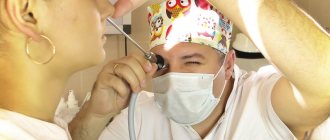The relationship between nose and head pain
The nose is one of the sections of the respiratory system. It consists of several departments interconnected. If diseases occur on the visible part of the nose, they are easy to diagnose. However, nasal pain can be caused by damage to the internal parts that are located inside the skull. To understand why the nose hurts and radiates to the head, it is worth familiarizing yourself with its structure.
- The outer nose is the visible part. Its shape is formed by cartilage and several bones, as well as facial muscles. This is the first section into which the inhaled air penetrates, so it is initially purified from small particles and microorganisms.
- The nasal cavity is an expansion formed by bones and cartilage. Its posterior part narrows and passes into the nasopharynx.
- Paranasal sinuses (paranasal sinuses) are additional cavities that are located on opposite sides of the nasal cavity. There are anterior and posterior sinuses.
All parts of the nose are covered with mucous membrane. It is continuous, contains nerves and vessels, and connects to the epithelial layer of the oropharynx. The nasal mucosa has a distinctive feature - it contains olfactory receptors, with the help of which the nervous system is able to distinguish odors. In addition, it is the first barrier against viruses and bacteria that enter the body with inhaled air and can cause infectious diseases of the respiratory system.
Diseases that cause nasal congestion and discomfort reduce the supply of oxygen to the lower respiratory system. This causes insufficient nutrition of tissues, especially brain cells. Most colds are accompanied by a headache, which occurs due to respiratory failure. In addition, colds are accompanied by swelling of the mucous membrane, inflammatory processes, and increased formation of exudate.
Diagnostics
In some cases, the patient may know what is causing their headaches and nasal congestion and may not need a diagnosis.
However, if he does not know the cause of his headache and nasal congestion or worsening symptoms, the patient should consult a doctor. The doctor will likely ask some questions about your symptoms and perform a physical examination.
In some cases, such as allergic reactions, your doctor may order tests to look for allergies or other signs of an underlying condition.
What can hurt your nose?
The most common cause of nasal pain is inflammatory reactions . They occur in response to the penetration of pathogenic microflora or mechanical damage. Inflammation can begin in any area, but often spreads to adjacent areas and affects several structures simultaneously. It often begins on the mucous membrane, as this is where the immune system's initial fight against viruses and bacteria occurs. Then the process can spread to the skin and subcutaneous tissue, cartilage tissue, blood vessels and nerves, paranasal sinuses, and nasopharynx.
Causes of pain in the nose and head
Pain in the nose that radiates to the head is the result of a number of pathological processes. They can be associated with internal or external factors that cause inflammation of the nasal structures or disruption of their anatomical integrity. Based on the exact location of the painful focus, its cause can be assumed. According to the mechanism of development, several main groups of diseases are distinguished:
- inflammatory processes - often occur with viral and bacterial diseases, but can also be associated with autoimmune processes and allergic reactions;
- injuries - accompanied by mechanical damage to the mucous membrane, skin and subcutaneous tissue, as well as cartilage tissue and other structures;
- Poor circulation in certain areas of the nose or nasopharynx is a less common cause of nasal pain and is associated with aseptic cell necrosis (death without the participation of pathogenic microflora).
Another classification distinguishes several groups of causes, depending on the location of the main cause of nasal pain. These include:
- diseases of the external nose - often represent damage to the skin and subcutaneous tissue (furuncle, carbuncle, erysipelas, eczema);
- diseases of the inner nose - can affect both the mucous membrane and bone and cartilage tissue, and also occur due to the ingress of foreign objects and injury to internal structures;
- diseases of the paranasal sinuses - represent a separate group of diseases that involve infection and inflammation of the mucous membrane;
- diseases that can simultaneously affect several structures of the nose - these include both viral and catarrhal rhinitis, as well as more dangerous pathologies (tuberculosis, granulomatosis).
It is important to determine the primary cause of nasal pain in order to select an effective treatment regimen. Doctors at the Clinical Institute of the Brain will make an accurate diagnosis in a short time, based on the results of the examination. Treatment tactics will differ for injuries, infectious diseases, allergic and autoimmune processes.
Rhinitis
One of the most common reasons why the nose and head hurt is rhinitis, or runny nose, inflammation of the nasal mucosa. It is a symptom of most colds caused by viruses and bacteria. Pathogenic microflora penetrates the nasal mucosa, where the main fight of the immune system against infection occurs. The process is accompanied by inflammation, redness and swelling of the mucous membrane, and increased secretion of exudate.
The main symptoms of rhinitis include:
- runny nose, nasal congestion – excessive exudation makes breathing difficult;
- pain in the nose - more often they are concentrated at the site of inflammation;
- headaches - occur due to difficulties with breathing, as well as as a result of deterioration in general well-being;
- itching and burning in the nose.
Treatment for rhinitis depends on its cause. If the disease is caused by a viral infection, it is important to strengthen the immune system and provide the patient with bed rest. To make breathing easier, the doctor will select medications in the form of nasal drops or spray. They contain anti-inflammatory and antiviral components, as well as substances that constrict blood vessels and reduce the appearance of a runny nose.
Sinusitis
Diseases of the paranasal sinuses can occur independently or as a complication of colds. Normally, paranasal sinuses are aseptic formations in which there is no pathogenic microflora. If viruses or bacteria penetrate the mucous membrane of the sinuses, inflammatory processes begin. The danger of the disease is that normally there is no fluid in the sinuses, so draining the exudate is difficult. The cavities can be filled with liquid contents or pus, depending on the cause and type of inflammation.
There are several main types of sinusitis, which develop in different paranasal sinuses:
- Sinusitis is inflammation of the maxillary (maxillary) sinuses. They are located to the left and right of the nasal cavity and connect to it. Sinusitis is the most common form of sinusitis, accompanied by pain in the nose, bridge of the nose and head.
- Frontitis is inflammation of the frontal sinuses. They are located above the nasal cavity, in the thickness of the frontal bone. They are paired, but connected to each other by a common partition. Frontal sinusitis is diagnosed less frequently than sinusitis, but is also a common type of sinusitis.
- Sphenoiditis is inflammation of the mucous membrane of the sphenoid sinuses, a rare pathology. These sinuses belong to the posterior ones and are located in the thickness of the sphenoid bone. Their lower wall is the upper arch of the inner nose. Despite the fact that sphenoiditis occurs rarely, it is considered a dangerous disease. This is due to the deep location of the sinuses, the difficulty of accessing them and difficult drainage of fluid.
- Ethmoiditis is inflammation of the mucous membrane of the ethmoid bone. Their number is not constant, in different people it can range from 8 to 10. The sinuses are cells of the ethmoid bone. Ethmoiditis rarely develops as an independent disease; it often accompanies other forms of inflammation of the paranasal sinuses.
A lingering runny nose, pain in the head and bridge of the nose, behind the eyes often indicates the onset of sinusitis. Other inflammatory diseases of the sinuses are diagnosed less frequently. It is useful to know about one characteristic symptom of sinusitis, with which the disease can be recognized even at home. To do this, you need to bend over sharply and lower your head to the ground. If at the same time acute pain begins in the nose and head, in the forehead and bridge of the nose, inflammation of the maxillary sinus can be assumed.
Treatment of sinusitis is prescribed individually. The most common method is nasal rinsing combined with a course of antibiotics. These drugs destroy bacterial microflora, thereby eliminating the symptoms of purulent inflammation. However, in acute forms of sinusitis, drainage of the maxillary sinuses may be necessary. The procedure consists of puncturing them, removing purulent contents and treating the mucous membrane with antiseptic solutions.
Injuries
One of the causes of pain in the nose and head is injury . Nasal fractures, damage to the nasal septum and other factors lead to disruption of tissue integrity and hemorrhages, deterioration of blood supply and innervation of certain areas. Injuries to the internal structures of the nose can also be caused by foreign bodies entering the nasal passages. The process is dangerous, since pathogenic microflora multiply in damaged areas, tissue suppuration and necrosis occur. In addition, if recovery is not performed correctly, the patient may find it difficult to breathe even after a long time.
Treatment for injuries is prescribed based on the results of the examination. If the bones and cartilage remain intact, and only damage to the skin, subcutaneous tissue and mucous membranes is detected, it is important to regularly treat these areas with antiseptics. In case of displaced fractures, an operation is prescribed, during which the bone fragments are returned to the anatomically correct position. With proper rehabilitation, breathing returns to normal without consequences.
Inflammatory diseases of the skin and subcutaneous tissue
Diseases of the skin and subcutaneous tissue can appear on both the outer and inner surfaces of the nose. They are often associated with the entry of pathogenic microflora and its reproduction in a favorable environment. In addition, inflammation develops as a result of microtraumas. There are several formations that can appear in different parts of the external nose, causing headaches and breathing problems.
- Furuncle - formed when the sebaceous gland is infected with staphylococci or streptococci. It is a small, painful raised area above the surface of the skin containing pus. Most often, boils appear on the skin, in the area of the tip or wings of the nose.
- A carbuncle is a larger formation that occurs when the sebaceous gland, one or more hair follicles are simultaneously infected. The process spreads to the skin, subcutaneous tissue and mucous membranes, causing their purulent melting. A carbuncle is a dense, painful formation of a red or bluish tint that causes acute pain and fever.
- Eczema is an allergic inflammation, but its exact cause has not been established. The skin of the tip and wings of the nose is often damaged. It becomes dry, turns red, cracks, ulcers and blisters filled with transparent aseptic content may appear on it. Due to a violation of its integrity, boils, carbuncles and other manifestations of skin suppuration may form in the affected areas.
- Erysipelas (erysipelas) is an infectious disease that affects the skin and subcutaneous tissue. It is caused by specific microorganisms, hemolytic streptococci. They cause inflammation, redness of the skin and subcutaneous tissue, as well as hardening of these structures. These areas are painful, and in many patients they are separated from the healthy skin of the nose by a noticeable ridge.
In infectious diseases, redness of the skin, swelling and an increase in local temperature are observed. Limited formations are less dangerous because the purulent contents are enclosed in a capsule. To get rid of them, a simple procedure is carried out in which the abscess is opened, cleaned and treated with antibiotic solutions. Diseases in which the pus is in a diffuse state require complex treatment using broad-spectrum antibacterial drugs.
Allergy
If your head and nose constantly hurt, or a chronic runny nose does not stop, this may be the first sign of an allergy. It is a pathological reaction of the immune system to various stimuli. If in a healthy person the immune factors react only to viruses and bacteria, then in an allergic person they react to any substances. Thus, dust and pollen, animal hair, household chemicals and dyes, and certain products often become allergens. When they enter the body, characteristic allergy symptoms appear:
- pressing headaches, dizziness;
- runny nose, difficulty breathing;
- deterioration in general health;
- swelling of the nasal mucosa;
- irritation and redness of the skin, itching, burning and rash.
At the first symptoms of an allergy, it is important to determine what caused it. The easiest way is to track what new substances the patient has been in contact with recently. Allergy tests are considered the most accurate method. Concentrated allergens are injected under the skin in the forearm and the reaction is observed for several days. If inflammation develops at the injection site and a painful swelling appears, it can be argued that this substance is an allergen. Antihistamines are used for treatment, which suppress the immune system's reactions.
A specific type of allergy is autoimmune reactions . They arise in response to internal factors and the body’s own tissues. Manifestations of these processes also include headaches, inflammatory reactions, damage to the skin and mucous membranes. Treatment is selected individually, its main stages are reducing the sensitivity of the immune system and anti-inflammatory therapy.
Herpes
Herpes is a viral disease with a chronic course. It can cause various diseases, including damage to the skin and mucous membranes. Small blisters form in the nose area, the skin becomes red and inflamed, and an itching and burning sensation appears. The bubbles are located close to each other, in a limited space. They open on their own, leaving behind small ulcers.
The herpes virus is present in the body of most people, but occurs in a latent form. An exacerbation is caused by a decrease in immunity, and therefore may be associated with colds. Antiviral and restorative drugs are used to treat it. However, after recovery, immunity is not formed. In addition, the virus continues to be present in the body, so another exacerbation can occur at any time.
Other reasons
The exact cause of the pain in the nose, which radiates to the head, can only be determined as a result of a complete examination. If viral rhinitis remains the most common diagnosis, then diagnostics may also reveal more rare and dangerous pathologies. To identify them, it is important to pay attention to all the signs and carry out the necessary tests.
The examination may reveal the following abnormalities:
- dental diseases (caries, abnormal growth and position of teeth);
- tuberculosis is a chronic disease caused by mycobacteria, which manifests itself, among other things, in the destruction of nasal structures and acute pain in the head;
- granulomatosis is a systemic autoimmune disease in which normal tissues are destroyed and replaced by dense connective tissue;
- neoplasms - can be found in any area;
- abnormalities in the structure of the nose, often manifested by a deviated nasal septum and difficulty breathing.
When diagnosing, the doctor takes into account all possible options, but is guided by the data of the examination and questioning of the patient. You should not be afraid of dangerous diseases if your complaints include a runny nose and headaches.
Stuffy nose and headache: nine main causes
A stuffy nose and headache can be the result of benign conditions such as colds and allergies.
However, sometimes they are associated with a condition that may require medical attention. In this article, we will discuss some of the causes of headaches and nasal congestion, as well as the treatment options available. We will also look at when a person should seek medical help.
Sinusitis
Sinusitis is a sinus infection that can cause mucus buildup and swelling. According to the American Academy of Allergy, Asthma and Immunology (AAAAI), an acute sinus infection often begins as a cold.
An initial cold can cause your sinuses to swell, trapping bacteria and mucus in the passages. According to the AAAAI, chronic sinusitis occurs when a person experiences three or more sinus infections within a year.
This usually causes sinus swelling and mucus buildup.
Symptoms of sinusitis:
- pressure around the eyes, forehead or nose
- rush of blood to the head
- nasal congestion
- cough
- discolored and thick mucus
- purulent nasal drips
- feeling of fullness in the ears
- headache, especially in the frontal part of the head
- toothache
- fatigue
- fever (rare)
Treatment
Most sinus infections are caused by viruses, and people can treat most sinus problems with over-the-counter medications.
However, if sinus problems persist or worsen after 7 to 10 days, the sinusitis is likely caused by bacteria. In these cases, the doctor may prescribe antibiotics. Antibiotics kill the bacteria that cause this infection.
Cold
According to the Centers for Disease Control and Prevention (CDC), a stuffy nose is a common cold symptom. Some people may also experience a headache from a cold, although this is a rare symptom.
Other cold symptoms:
- cough or mild chest pain
- a sore throat
- sneezing
- fever (rare)
- weakness or fatigue
Treatment
Treatment for a cold usually requires rest and increased fluid intake. The patient may also take over-the-counter medications such as acetaminophen and ibuprofen.
Home remedies such as humidifiers or inhalations may also help control symptoms.
If symptoms do not go away within 10 to 14 days, the patient should talk to their doctor as they may have a sinus infection.
Flu
Influenza, or influenza, is a respiratory disease caused by influenza viruses.
Those who have the flu may also experience nasal congestion and headaches.
According to the CDC, other symptoms include:
- cough
- a sore throat
- muscle pain
- fatigue
- fever (sometimes)
Some people may experience vomiting and diarrhea, but these are more common in children than adults.
Some people with the flu may develop serious complications. The patient should seek emergency medical help if they experience any of the following symptoms:
- labored breathing
- chest pain
- constant dizziness
- convulsions
- severe muscle pain
- severe weakness
Treatment
The sooner treatment begins, the better. Your doctor may also prescribe antiviral medications to prevent complications from occurring.
Allergies
Allergies can cause nasal congestion and headaches. When an allergy causes a headache, the sufferer may also experience other symptoms, such as:
- watery and itchy eyes
- runny nose
- pain in the face around the cheeks and nose
Treatment
The patient should avoid allergic triggers whenever possible.
Treatment for allergies consists of over-the-counter medications such as antihistamines and nasal decongestants.
If over-the-counter medications are not effective, the patient should talk to their doctor about prescription medications or allergy shots.
Respiratory syncytial virus (RSV)
Respiratory syncytial virus (RSV) is an infection of the nose, lungs and throat. Although anyone can get it, it is more common in children. RSV is a cause of bronchiolitis in children.
This virus can cause a dull or mild headache and nasal congestion.
In some cases, RSV can cause other symptoms, such as:
- cough
- heat
- fatigue
- dyspnea
- a sore throat
- wheezing in the chest
Treatment
Most healthy adults and children can treat RSV at home and it will go away within 1 to 2 weeks.
In these cases, over-the-counter medications can help relieve symptoms. However, parents should talk to a doctor before giving medications to children.
The CDC says older adults, infants and people with weakened immune systems are at higher risk of developing severe symptoms and should see a doctor if they have trouble breathing.
Ear infections
Ear infections can also cause headaches and nasal congestion. Ear infections can be caused by both viruses and bacteria.
Fluid from the ear can enter the nasal passages and cause an infection in the nose.
Some common symptoms of an ear infection include:
- hearing loss
- ear discharge
- heat
- difficulty sleeping
Treatment
Some home remedies can help get rid of an ear infection. Steps the patient can take include:
- decongestants
- using a warm compress
- rest
- drinking more fluids
- taking over-the-counter pain medications
- using over-the-counter ear drops
If home treatments do not work, the patient should talk to a doctor.
Your doctor may prescribe an antibiotic to treat a bacterial infection.
The patient should seek medical help if the following symptoms occur:
- high temperature 38.8°C or higher
- worsening symptoms
- hearing loss
- ear discharge
Migraine
A migraine is a severe, throbbing headache that usually affects one side of the head. Migraines can cause nasal congestion.
The pain may be chronic, meaning it may recur.
Other symptoms may include:
- nausea
- photophobia
- blurred vision
- vomit
Treatment
There are several different treatment options for migraines, although they may not work for everyone.
Treatment is usually aimed at preventing the attack or symptoms.
The patient should talk with their doctor about the best treatment options.
Nasal polyps
Nasal polyps are benign growths in the nasal passages. Some polyps may not cause any symptoms at all.
Other symptoms:
- nasal discharge
- pressure in the facial sinuses
- nasal congestion
- deterioration of sense of smell
Treatment
Doctors usually treat nasal polyps with steroids and saline washes. According to the AAAAI, steroids usually reduce the size of polyps. However, polyps often return, and some patients may require long-term treatment or sometimes surgery.
Pregnancy
Pregnancy can also cause headaches and nasal congestion.
Various factors, including changes in hormone levels during pregnancy, can cause headaches and nasal congestion in women.
According to a 2012 study, rhinitis is common during pregnancy.
Symptoms of rhinitis include sneezing and runny nose.
A pregnant woman should talk to her doctor about any symptoms she experiences.
Treatment
Your doctor may recommend safe medications or treatments to help with your headaches.
The patient can also try:
- yoga for pregnant women
- practice good posture
- neck and shoulder massage
- rest more
- to eat well
- use a cold compress to relieve tension headaches
- use warm wipes on the eyes and nose if the cause is a sinus headache
Diagnostic methods
Before starting treatment, the doctor will prescribe an examination that will determine the cause of pain and poor health. As a result of the examination, swelling, redness of the skin and mucous membranes of the nose, rash and other characteristic signs of a number of diseases can be detected. The patient needs to clarify when and under what conditions the first symptoms appeared. However, additional techniques will be required to make a final diagnosis.
- Rhinoscopy is one of the simplest procedures that allows the doctor to examine the internal structures of the nose using a mirror. To examine the anterior parts of the nose, it is enough to use a nasal speculum. It is wide and is used to assess the condition of the nasal turbinates and septum, as well as the mucous membrane. If necessary, the doctor uses a nasopharyngeal speculum. It is small, placed on a thin metal stick. Access to the tissues under study is carried out from the oropharynx.
- Endoscopy is a more invasive, but informative procedure. It is performed using an endoscope. It is a miniature camera on a thin, flexible tube that easily follows the movement of the nasal passages. Endoscopy allows you to examine the mucous membrane of the internal structures of the nose, identify injuries and neoplasms, and also take samples for biopsy.
- Diaphanoscopy is a method of examining the paranasal sinuses. It is performed in a dark room, with a special glowing lamp in the patient’s mouth. Normally, the sinuses are filled with air, so they are visible during diaphanoscopy. However, when they are filled with liquid or purulent contents, they become dark.
- Ultrasound diagnostics - prescribed for suspected sinusitis and frontal sinusitis. However, for most diseases of the inner nose, this technique is ineffective.
- CT, MRI - are used when injuries, neoplasms, or structural anomalies of the internal structures of the nose are suspected. The procedures are planned and prescribed when standard diagnostic methods are insufficiently effective.
The Clinical Institute of the Brain has all the capabilities for full diagnostics. The doctors have high-quality, modern equipment and many years of experience in treating diseases of the nose and head. They can ensure that the examination will involve a minimum number of tests to help determine the cause of the pain and the stage of the disease.
Odontogenic maxillary sinusitis - symptoms and treatment
Often, treatment of odontogenic maxillary sinusitis is carried out using a combination of conservative and surgical methods. The method of treatment and its volume depends on the causative factor and the course of the disease.
For odontogenic sinusitis caused by acute or aggravated periodontitis, treatment often consists of eliminating the causative factor and prescribing drug therapy. To eliminate the cause of inflammation, endodontic treatment of the root canals of a diseased tooth is performed, followed by filling.
In case of extensive destruction of the coronal part of the tooth, its strong mobility, as well as the patient’s refusal to preserve the causative tooth, its extraction (removal) is carried out. If by the time of treatment the patient has developed a purulent form of sinusitis, a puncture of the maxillary sinus is performed with evacuation of purulent contents and daily washing of the sinus with antiseptic solutions. Drug therapy is prescribed. In the catarrhal form of acute maxillary sinusitis, sinus puncture is not required; drug therapy and lavage through the natural anastomosis are prescribed.
Treatment of odontogenic maxillary sinusitis is usually an interdisciplinary problem: the disease is jointly treated by dental therapists, dental surgeons, maxillofacial surgeons and otolaryngologists. The number of specialists depends on the severity of the disease.
For odontogenic cysts of the maxillary sinus, the presence of filling material and other foreign bodies in the lumen of the maxillary sinus without oroantral communication (pathological communication between the sinus cavity and the oral cavity), surgical treatment is indicated. There are several types of operations on the maxillary sinus.
Radical maxillary sinusotomy according to Caldwell-Luc. Under general anesthesia, the mucous membrane and periosteum in the vestibule of the oral cavity are dissected from the canine to the second molar. A raspatory is used to skeletonize (expose) the bone tissue, after which the anterior wall of the maxillary sinus is trepanned (created access). The burr hole is expanded to 1.5*1.0 cm, the mucous membrane of the anterior wall of the sinus is excised and all pathological tissues and fluids are removed from the sinus: pus, polyps, foreign bodies, cyst membrane, blood clots, etc. This type of operation requires extremely careful execution, because it is necessary to remove all pathological tissue in the least traumatic way, without affecting the healthy mucous membrane of the sinus. Also, during the operation, an additional communication is created between the sinus cavity and the nasal cavity, into which tubes are subsequently installed for subsequent rinsing with antiseptic solutions. Afterwards, the postoperative wound is sutured and drug therapy is prescribed. The material obtained during the operation is sent for pathohistological and bacteriological examination. According to the literature, this surgical method has complications in the postoperative period in 80% of cases [18]:
- replacement of ciliated epithelium with scar tissue;
- fusion of the natural anastomosis with the nasal cavity;
- impaired sensitivity of teeth and adjacent soft tissues;
- trauma to the nasolacrimal duct;
- lacrimation;
- osteomyelitis of the upper jaw and zygomatic bone.
With a gentle micromaxillary sinus, an incision of about 8 mm is made in the area of the canine fossa, the anterior wall of the maxillary sinus is trepanned, the hole is widened for the introduction of an endoscope and endoscopic surgical instrument. The maxillary sinus is sanitized (cleansed), foreign bodies and pathological tissues are removed under endoscopic control. This method makes it possible to achieve adequate sanitation of the sinus cavity with minimal trauma.
A more modern surgical intervention is trocar sinusotomy, in which a puncture of the mucous membrane in the area of the canine fossa is performed, followed by trepanation of the anterior wall of the maxillary sinus and insertion of a trocar (an instrument designed to penetrate into the body cavity through the integument) into the resulting hole, through which an endoscope and endoscopic instruments are inserted. instruments for surgical sanitation of the sinus. With micromaxillary sinusotomy and trocar sinusotomy, an additional anastomosis is not applied.
Methods for sanitation of the sinus through the natural anastomosis without punctures and incisions are possible; such treatment methods are carried out by otolaryngologists.
Special attention should be paid to the treatment of perforated forms of maxillary sinusitis, as one of the most common forms. At the moment, there are many ways to close perforation of the floor of the maxillary sinus, many of which only slightly differ from each other in the methodology. All techniques pursue the following goals:
- reliable closure of the perforation hole;
- relapse prevention;
- prevention of the formation of persistent oroantral anastomosis.
The most commonly used are various variations of defect replacement with a cheek flap. The point is the same:
- sampling of the mucous membrane of the alveolar process of the upper jaw;
- formation of a mucoperiosteal flap, its mobilization (creation of mobility) and movement to the palatal surface, followed by suturing.
The obvious disadvantage of this method is that it provides only soft tissue regeneration in the area of the perforation hole [19]. Also, the disadvantages of this method include the loss of attached keratinized gum (an immovable cuff, a barrier that protects the tooth and the bone around it from the traumatic effects of food bolus, penetration of microbes and other factors). In addition, the operation can lead to a decrease in the depth of the vestibule of the oral cavity (the space of soft tissue between the lip or cheeks and the elements of the dentofacial row), which threatens the development of gingivitis, periodontitis, the formation of malocclusion, loosening of teeth and other pathologies.
To preserve the attached keratinized gum and the depth of the vestibule of the oral cavity, a palatal flap on a pedicle began to be used. The disadvantages of this method include extensive trauma and a large wound surface of the hard palate. In this regard, splitting of the palatal mucoperiosteal flap is currently widely used. However, these methods also do not allow restoration of lost bone tissue volume. To restore the bone tissue of the alveolar process in the area of the perforation hole, various synthetic and natural bone replacement materials are used.
Treatment of pain in the head and nose
Treatment tactics are selected individually, depending on the exact diagnosis and the nature of the disease. Most diseases can be treated with medication, but in some cases surgery is necessary. The course may include the following stages:
- taking antibiotics is a mandatory measure for bacterial diseases, purulent inflammation, injuries, sinusitis;
- supportive treatment, which includes anti-inflammatory and vasoconstrictor drugs, antipyretics and analgesics;
- antiviral drugs;
- surgical treatment - consists of opening and washing abscesses, boils, as well as sanitizing the paranasal sinuses for sinusitis.
Doctors at the Clinical Institute of the Brain will select the most effective treatment regimen, which will include only the necessary steps. The drugs can be taken on schedule at home, only in some cases treatment in a hospital is indicated. The patient remains to follow all recommendations and regularly return for re-examination.
Prevention methods
Doctors have several recommendations on how to prevent the manifestation of the disease, which causes pain in the nose and head. They include the following activities:
- support for general immunity, including proper nutrition, sufficient vitamins, regular physical activity;
- tests for suspected allergies to identify the irritant and stop contact with it;
- timely diagnosis to identify sinusitis, neoplasms and other dangerous diseases that may progress over time.
The Clinical Brain Institute specializes in the diagnosis and treatment of all types of headaches, including those associated with nasal diseases. To receive recommendations for treatment and prevention, all you need to do is make an appointment and undergo a full examination. Our center is equipped with modern tools for diagnostics and treatment procedures, and our doctors are experienced specialists in a narrow and broad profile.
Clinical Brain Institute Rating: 4/5 — 3 votes
Share article on social networks







